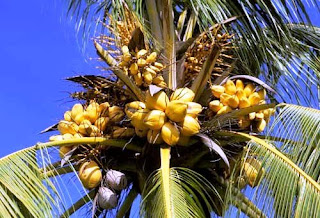Try to get up as late as possible to face the Good Friday of stringent fasting. Everyone who has received First Holy Communion has to observe it, till the age of 60. Just one meal, lunch, on the day. No meat or fish for the whole of Lent.
One saving factor was the INRI Appam from the previous night. Now, this Appam is made from a special recipe, only on Maundy Thursday, for the solemn dinner. The head of the house would cut the Appam after prayers and hand over a piece to each member of the family, symbolic of the Last Supper.
The INRI Appam is light brown bread made from roasted rice flour and urad dal and served with a sweet sauce made from coconut milk and jagerry, thick and brown. In Western Christianity Holy Cross Buns are used in its place.
Several of these Appams would be made. Those to be served on the table, distributed to the nearby Christian families, and given to the church would have crosses on them. These were made with strips from the coconut leaves blessed and distributed on Palm Sunday. (Incidentally, every adult male member of the Parayil Family was given a full tender coconut frond, almost similar to the one for the priest, while the others had to be satisfied with one or two individual leaves.)
On Good Friday morning one was permitted to have ‘limited’ quantities of Appam and sauce. The limit was flexible, but nowhere near full breakfast. Strangely, one invariably felt hungrier on Good Friday than on other mornings. The leftover Appams were cut into thin square pieces, crisp fried and stored. That was a favorite and the containers emptied fast.
No mass on Good Fridays. Long sessions of Bible reading, till lunch. There used to be one curry everyone looked forward to. The main ingredient was tender cashew kernels. The servants were experts at removing the kernels unbroken from the soft green nuts. The recipe also included drumsticks and other vegetables. Delicious!
Then came the most tedious part of the day – the long church service in the afternoon. The ritual included swallowing ‘bitter juice’, a concoction made from some leaves. Nothing could be more bitter. That is symbolic of what the soldiers gave Jesus to quench His thirst. But then nothing lasts forever. Back home, an early dinner of ‘limited’ quantity of Appam and sauce, and off to bed.
Holy Saturday was normally quiet, uneventful, except for us, in 1959. Appan. died that evening. The priests wore colorful vestments instead of the traditional black for the funeral, because it was held on Easter Sunday.
Ends.















